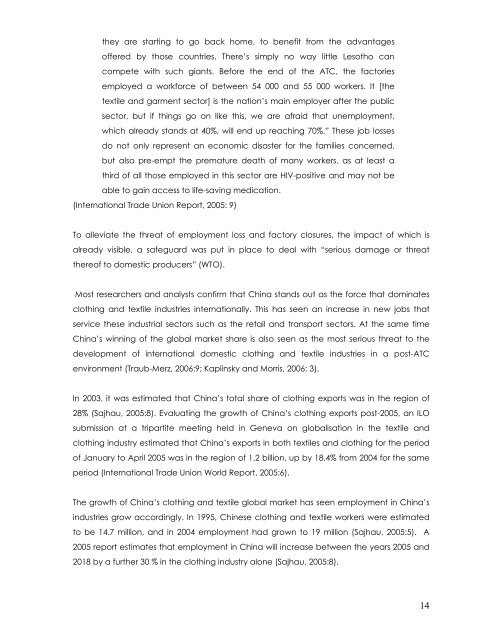You also want an ePaper? Increase the reach of your titles
YUMPU automatically turns print PDFs into web optimized ePapers that Google loves.
they are starting to go back home, to benefit from the advantages<br />
offered by those countries. There’s simply no way little Lesotho can<br />
compete with such giants. Before the end of the ATC, the factories<br />
employed a workforce of between 54 000 and 55 000 workers. It [the<br />
textile and garment sector] is the nation’s main employer after the public<br />
sector, but if things go on like this, we are afraid that unemployment,<br />
which already stands at 40%, will end up reaching 70%.” These job losses<br />
do not only represent an economic disaster for the families concerned,<br />
but also pre-empt the premature death of many workers, as at least a<br />
third of all those employed in this sector are HIV-positive and may not be<br />
able to gain access to life-saving medication.<br />
(International Trade Union Report, 2005: 9)<br />
To alleviate the threat of employment loss and factory closures, the impact of which is<br />
already visible, a safeguard was put in place to deal with “serious damage or threat<br />
thereof to domestic producers” (WTO).<br />
Most researchers and analysts confirm that China stands out as the force that dominates<br />
clothing and textile industries internationally. This has seen an increase in new jobs that<br />
service these industrial sectors such as the retail and transport sectors. At the same time<br />
China’s winning of the global market share is also seen as the most serious threat to the<br />
development of international domestic clothing and textile industries in a post-ATC<br />
environment (Traub-Merz, 2006:9; Kaplinsky and Morris, 2006: 3).<br />
In 2003, it was estimated that China’s total share of clothing exports was in the region of<br />
28% (Sajhau, 2005:8). Evaluating the growth of China’s clothing exports post-2005, an ILO<br />
submission at a tripartite meeting held in Geneva on globalisation in the textile and<br />
clothing industry estimated that China’s exports in both textiles and clothing for the period<br />
of January to April 2005 was in the region of 1.2 billion, up by 18.4% from 2004 for the same<br />
period (International Trade Union World Report, 2005:6).<br />
The growth of China’s clothing and textile global market has seen employment in China’s<br />
industries grow accordingly. In 1995, Chinese clothing and textile workers were estimated<br />
to be 14.7 million, and in 2004 employment had grown to 19 million (Sajhau, 2005:5). A<br />
2005 <strong>report</strong> estimates that employment in China will increase between the years 2005 and<br />
2018 by a further 30 % in the clothing industry alone (Sajhau, 2005:8).<br />
14
















